Inconsistent Pleadings: Another Thing White People Like: Judging
by Ian Retford
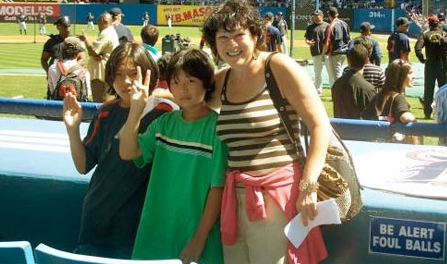
The San Francisco Chronicle recently reported that Vaughn Walker, the James Coburn/Wilford Brimley look-alike who is overseeing the federal court challenge to California’s Proposition 8, is gay. (Awkward!) Since the story broke, journalists and pajama-bloggers have debated whether it’s appropriate for a gay man to adjudicate the constitutionality of a law aimed specifically at depriving gays of their rights.
This is an interesting question, if ultimately an academic one. As Vaughn himself has noted, the Prop 8 case will make a relatively brief stop in his courtroom before moving on to the Court of Appeals and possibly the Supreme Court, where the lawfulness of the referendum will ultimately be decided.
The real news in the Chronicle story was the sheer improbability that a gay rights case would get assigned to a gay judge. Out of more than 1,000 federal judges in the country, there are only two that are known to be gay: Vaughn, and a federal trial court judge in Manhattan, Deborah Batts. Using the most conservative estimates of their share of the population (not to mention their share of the legal population!), gays are underrepresented on the federal bench by, at least, the dozens.
Gays are not alone. The only demographic group that is overrepresented on the federal bench is white men, who, while constituting around 37% of the population, make up around 70% of federal judges. Contrast this with the percentage of federal judges who are women (17%), African-American (8%), or Hispanic (5%). As of 2009, there were 8 Asian-American federal judges. Eight, total. (These numbers are courtesy of a report [PDF] from the Brookings Institution.)
Enter Obama. As President, he has authority to appoint judges to all three levels of the federal judicial system: (1) trial courts, or District Courts, where federal cases are initially filed; (2) Courts of Appeals, also called Circuit Courts, to which decisions of the District Courts are appealed; and (3) the Supreme Court, which hears appeals from the Courts of Appeals.
Thus far, Obama has nominated 43 people to the federal bench, including Sonia Sotomayor. Although it should shock no one that the nominees are a diverse bunch, the specific statistics are nonetheless dramatic: 50% women; 26% African-American; 7% Hispanic; 14% Asian; and only 30% white male. Whites overall, who make up 85% of the current crop of federal judges, are only 53% of Obama’s nominees.
The diversity of Obama’s nominees stands in stark contrast not only to the current makeup of the federal bench but, more surprisingly, the nominees of past Democratic presidents. More than 60% of Jimmy Carter’s judicial appointments were white men, and Bill Clinton, whose desire for non-white/non-male appointments turned occasionally desperate, tapped the white guy more than 50% of the time.
So Obama appears to have a commitment to increasing the diversity of the federal bench, although it’s not something he seems particularly eager to talk about. (No public promises, a la Clinton, for a bench that “looks like America.”) Nor is it something that’s gotten a lot of press. But Obama’s nominations, though low-profile, are likely to be high-impact. Lower federal court judges, like Supreme Court justices, serve until death or retirement, whichever comes first. (The oldest federal court judge, appointed by JFK, is 102 years old.) Thus, the people nominated by Obama could (if confirmed by the Senate) rule on, for example, the scope of Constitutional protections for the next several decades.
The importance of lower federal courts is underappreciated. The Supreme Court gets more attention, but most of the action in the federal court system happens in the District Courts and the Courts of Appeals. The Supreme Court has near-complete discretion over its docket, and in recent decades has chosen to hear fewer than 100 cases per year. (For comparison: in 2009, more than 11,000 cases were filed in the District Court covering Manhattan.) For the vast majority of litigants, the ride through the federal court system stops well short of Justice Sonia and friends. The diversity of the Supreme Court Justices serves an important symbolic function, but diversity on the lower courts has a much greater chance of actually affecting your life.
Whether the race or gender of a judge actually influences the decision-making process is a topic of intense (and, typically, ill-informed) debate. Justice O’Connor has said many times that a wise old man and a wise old woman will usually reach the same result, and Justice Sotomayor has said… something different. (Studies seem to support Sotomayor, at least in part.)
This debate aside, there is a practical advantage to Obama’s picks: he’ll have a stable of well-qualified female and minority candidates to chose from if there is another Supreme Court vacancy during his term (which likely there will), and he may decide to fill the spot with someone who is non-white or non-male (which likely he will). Obama’s nominations might be grounded more in politics than in principle. But can we really argue with any efforts that help remake the federal judiciary in our image?
Ian Retford is the pseudonym of a lawyer in New York City.
Chemical Weapons Explosion Party Coming Soon!
What could go wrong? “Under the gun to destroy the U.S. chemical weapons stockpile-and now all but certain to miss their deadline-Army officials have a plan to hasten the process: Blow some of them up. The Army would use explosives to destroy some of the Cold War-era weapons, which contain some of the nastiest compounds ever made, in two communities in Kentucky and Colorado that fought down another combustion-based plan years ago.”
Sally Quinn, Disinvited
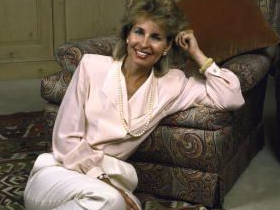
[CORRECTION APPENDED: Due to a totally reasonable inability to keep all of the Bradlee divorces straight, we did indeed get one of the Bradlee divorces slightly confused! A correction is inserted; a handy family tree of the Bradlee family will surely be published at a later date.]
Choire: We need to discuss DAVID PATERSON: THE TOLD UNTOLD STORY but my mind is so blown by Sally Quinn that I can barely think.
Tom: I KNOW RIGHT??
Choire: I mean, for starters, I’ve never gotten over them naming their son Quinn Bradlee? This naming speaks either of WASP customs I don’t understand or narcissism. (If those aren’t the same two things.)
Choire: But not being a Washington insider like yourself, I was not aware of this controversy about the Bradlee clan’s wedding dates, though I did just Google up a post from Politics Daily on the subject.
Tom: It is hard to know where to begin with this Quinn piece, but one way to begin is to pull back and take the wide-angle view, which is that she believes she has been given a column in the Washington Post Style section to deal with her personal business.
Choire: A WaPo Tumblr. About time!
Tom: I also had no idea that there was any controversy about wedding dates until Sally Quinn got into my morning newspaper and told me about it. I guess we, unlike Sally Quinn, don’t have Google alerts for “Sally Quinn.” But her column helps us make up for our failing.
Tom: Otherwise we might have missed the fact that anyone had something bad to say about Sally Quinn.
Tom: But. Could anybody have anything worse to say about Sally Quinn than Sally Quinn does? The column is like a particularly unhinged and confused letter to an advice columnist, only no advice columnist ever shows up to point out how self-deluded and wrong the letter-writer is. It is the Garfield Without Garfield to Ask Amy.

Tom: Sally Quinn is very upset that people have said that two sets of Bradlee offspring are having dueling weddings. She is so upset that she has gone to great lengths to explain the real situation.
Choire: Which is… that there are dueling weddings, I’m pretty sure?
Tom: The real situation, according to Sally Quinn, is that two branches of the Bradlee family hate each other so much — and one hates Sally Quinn so much in particular — that they have scheduled their weddings directly against each other, and the family is fully divided between the two occasions.
Choire: That’s pretty much what I read!
Tom: That is what she describes!
Choire: Also that Ben Bradlee keeps the calendar, but not ably. (What is also fascinating however is that her husband, Ben Bradlee, goes unnamed throughout!)
Tom: Well, let’s get to that in a moment.
Tom: Here’s the background on the two weddings, as rendered by Sally Quinn: “Over Christmas, Greta’s mother and I came to an understanding that, because of existing tensions, it would be best for all if none of us attended Greta’s wedding.”
Choire: An understanding, you say.
Tom: She doesn’t specify how many people “none of us” embraces.
Tom: But Greta is the daughter of Ben Bradlee Jr., her husband’s son. [CORRECTION: Due to the fantastic inability of the Bradlee clan to make any sense from the outside, it is only through diligent reporting that we have discovered that Greta’s mother is not Bradlee’s ex-wife, as we assumed; Greta is, apparently, Bradlee’s granddaughter, descended from a previous wife (his first, we believe, but we will consult the literature further).]
Choire: (Who IS named!)
Tom: So the “us” seems to include the entire family unit created by Ben Bradlee Sr. after he got out of his previous marriage.
Choire: I… think so?
Tom: The perfection of the marriage of Sally Quinn and Ben Bradlee is one of the central themes of the writing of Sally Quinn. It is odd that such a wonderful thing as this marriage would have created so much apparent emotional damage and resentment in its wake, lasting down through the years.
Tom: It is almost as if other people had different feelings about the marriage than Sally Quinn does.
Choire: It is known however that there are some deep-seated feelings within the family, that has created a rupture, related or not related to that marriage.
Tom: Now, you mentioned the calendar-keeping business.
Choire: I did. Personally, I would expect better household record-keeping from the former social secretary to a leader of the Algerian independence fighters.
Tom: Although it’s not completely apparent from this installment, the official or ostensible purpose of Sally Quinn’s Post column is to allow her to share her expertise about the handling of social functions.
Tom: This is her specialty.
Tom: Parties and special events and how to run them.
Tom: Yet she hands off the save-the-date card for this wedding to her husband, puts the date entirely out of her mind, and then blames him for forgetting it.
Choire: Do you find that implausible?
Tom: I do! It does not seem plausible to me.
Tom: It would seem to require an active act of forgetting and rejection on her part.
Choire: It is possible and also not likely.
Choire: And I say that as someone who is excessively, aggressively disorganized regarding dates.
Tom: Yes, I have a bad time keeping track of dates, too. But I do tend to remember at least the season of the year involved when someone tells me of an upcoming wedding.
Tom: It also occurs to me that people don’t send out Save the Date cards to people whom they are not planning to invite to their weddings.
Choire: That would follow.
Tom: So this understanding that was reached between Sally Quinn and “Greta’s mother” — why, Greta’s mother, that would be Ben Bradlee’s previous wife — this understanding amounted to the rescinding of an invitation.
Choire: A date had been saved!
Choire: Then a date was no longer to be saved.
Tom: “Happily, we did not have a single overlapping guest,” Quinn writes. That is true, but it was not always true.
Tom: Except Quinn also writes there, “We had already decided not to go to the California nuptials.” But “we” would seem to mean her and Ben Bradlee, which contradicts the earlier account of her non-attendance being settled by a discussion between her and Bradlee’s ex-wife.
Tom: She didn’t decide; she was disinvited.
Choire: And, correspondingly, or not, also clearly did not extend invitations the other way (by agreement?) in planning the wedding of her son. (Not a single overlapping guest!)
Tom: And then — because they were “thrilled to learn” that their daughter-in-law-to-be was pregnant — she moved up the wedding date to conflict with the California wedding.
Choire: Thrilled! Which I actually think is a nice way of discussing that. They should be thrilled. And forthright.
Tom: But Sally Quinn was restricted in her choice of wedding dates because of the liturgical calendar, she says.
Choire: Lent!
Tom: Plus the trouble of lining up the caterer and the band. But, you know, the courthouse doesn’t close for Lent. And the church would be perfectly happy to sanctify and solemnize existing secular vows at a later date.
Choire: But that is not a proper wedding for these people. (Although the yoga instructor bride might feel differently?)
Choire: In the end I think this Quinn column actually just makes me feel bad for everyone involved, and by everyone, and involved, I even mean myself! Now I’m involved, and I’m sad about it.
Tom: Isn’t that what science says the narcissists do to us?
Choire: It’s sometimes hard to tell a newspaper columnist from a narcissist but there is a difference and in this case this is not particularly newspaper columnizing? My main objection being that the story presented makes no sense, because I suspect that Sally Quinn has no idea that anyone is reading this who is not a Matrix-double of herself.
Tom: It is based on the premise that there is nothing embarrassing about being Sally Quinn.
Tom: I am not sure that anyone on the planet besides Sally Quinn feels that way.
Choire: Well, and now we know that only somewhere between 1/5th and 1/3rd of the Bradlee family at large agree with that opinion as well.
Tom: Or they don’t want to spring for cross-country airfare.
Choire: Sure. Weddings are annoying AND expensive!
Tom: Oh, my goodness. Only now did I bother finishing reading the original gossip item to which Sally Quinn had so helpfully pointed me. The church which she was having such trouble lining up seems to be the National Cathedral.
Choire: Oh yes, the little neighborhood church around the corner!
Tom: On behalf of all of us Episcopalians, I say Henry VIII would be proud.
Even Cancer Sufferers Are Chatting About Famous Person
86-year-old Senator Frank Lautenberg (D-NJ) has received a diagnosis of stomach cancer following an incident in which he was hospitalized with a bleeding ulcer. The cancer is treatable, and the senator’s spokesfolk say that Lautenberg will be just fine and still plans to run for re-election when his term expires in 2014. And he’s keeping up with the news! “In recent days, Lautenberg had been in touch with his staff and was on the phone a short time ago discussing the [Very Bad Things done by a Very Famous Person], his aides said .” So there’s that!
Your Tattoo And You

The comments section on this question about “tattoo regret” make for interesting reading, if you enjoy the occasional thread of people shouting past each other and making easy assumptions (a.k.a. “The Internet”). Disclosure: I am myself tattooed! I have a small skull on my right forearm. Technically it is upside-down, so it is occasionally mistaken for a snowman or a buttcrack. I got it in the “hip” section of Houston, Texas, in 1992. It cost $30. My theory at the time was that if you were going to get a tattoo it should be as tacky as possible, and I almost got inked with Bart Simpson’s head. Unfortunately (from a theoretical standpoint; this is one of those moments of relative poverty for which I will be forever grateful), Bart Simpson’s head cost $35, which was $5 more than I had on me. Thus the skull, which is suppose was some sort of tribute to Keith Richards’ ring. Do I regret it? I do not. Most days I do not even remember that it is there. It is generally only when I give blood that I actually notice it, and each time I do I think, “Oh, yeah, that guy!” What does my tattoo say about me as a person? It says that I was in my teens during the nineties. And that is my tattoo story. I hope you enjoyed it. Perhaps you have one of your own.
The Tryon in Winter
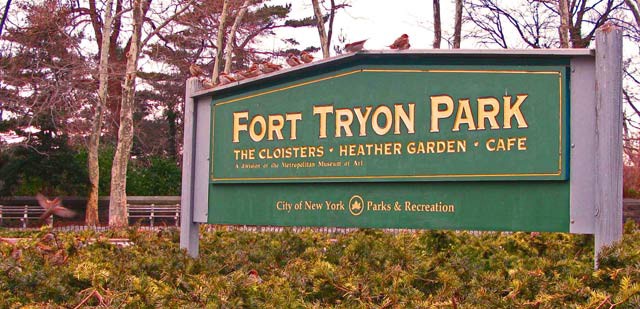
In the decade-plus I’ve lived in Washington Heights, I had never been to Fort Tryon Park in February, but this year, motivated by a resolution to run more (a resolution that slipped by in January), I went twice. The first time was on the weekend of the snowstorm that walloped much of the East Coast but managed to miss New York City, stopping-or so I heard-at Staten Island. After heading north on Fort Washington Avenue, which ascends along the western ridge of upper Manhattan, I arrived at the park on 190th Street, where I was greeted by a crescent of elegant sycamore trees and a coterie of chirping sparrows.
I passed between the stone pillars marking the entrance and was both surprised and amazed to find the heather garden already in bloom.

Adding to the coral-reel effect were Scottish brooms, patches of cotoneaster and-in the distance-he medusa-like branches of a colonnade of American elm trees.

Below me, a grotto of Eastern White Pines-one of the most dignified of all the evergreens in the city-provided a screen against the low afternoon sun.
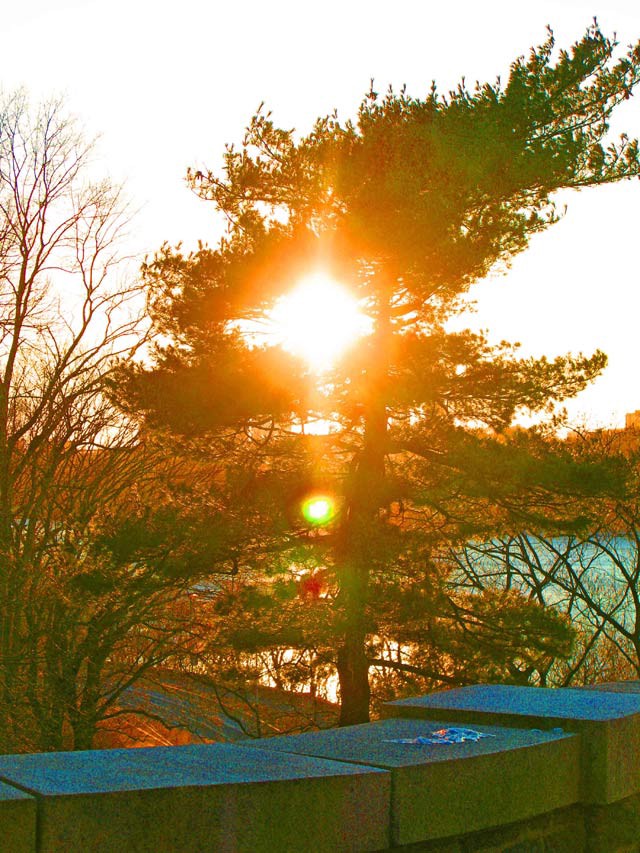
Fort Tryon Park was designed by Frederick Olmstead, Jr. (the son of the Central Park architect) and completed in 1935 with money and land provided by John D. Rockefeller. (The Cloisters-the branch of the Metropolitan Museum dedicated to medieval art-was built at the same time.)
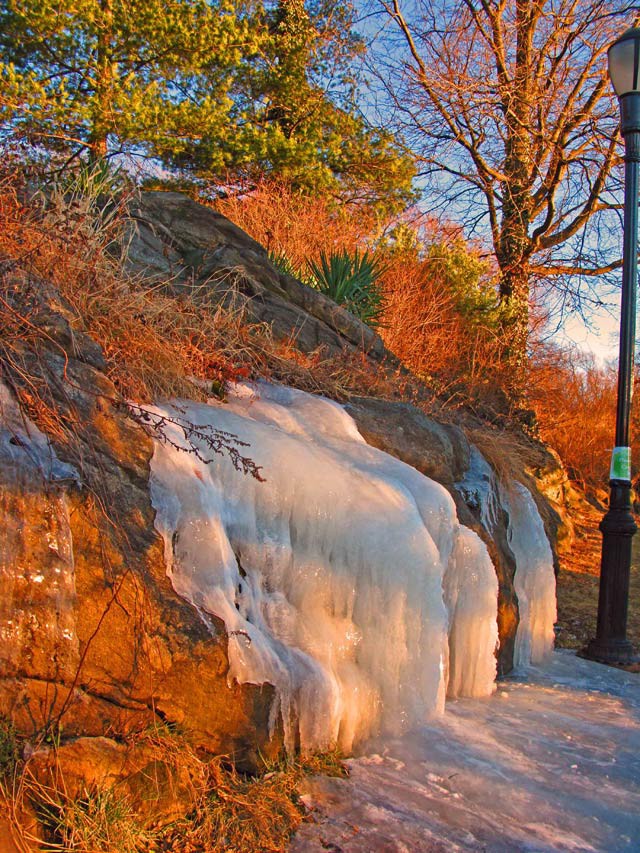
As I strolled along the elaborate network of paths and tunnels so beautifully embedded into the Manhattan schist that forms the bedrock of the island, I looked at the George Washington Bridge (completed in exactly four years, from 1927–1931) and wondered whether our current society will be known for having built such magnificent and enduring public works. I considered that Fort Tryon fell into serious disrepair during the middle decades of the last century before being restored in the late 1980s (with the help of Bette Midler, who is something of a patron saint in these parts for this reason), and it occurred to me that perhaps the restoration and maintenance is the best we can hope for in the modern era, when everything is so expensive and politically complicated.
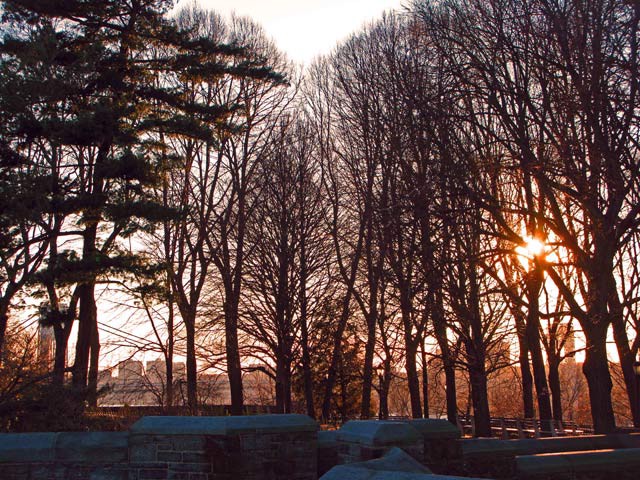
A week later I returned, a few days after the snowstorm. As expected, much of the park was buried under windswept drifts, but was no less beautiful for the lack of color.

I think one of the reasons snow evokes such intense feelings of nostalgia for so many people-or maybe I should narrow that down to myself, now that I’m looking back on 40-is that it provide evidence for the idea that our lives can change radically in an instant.
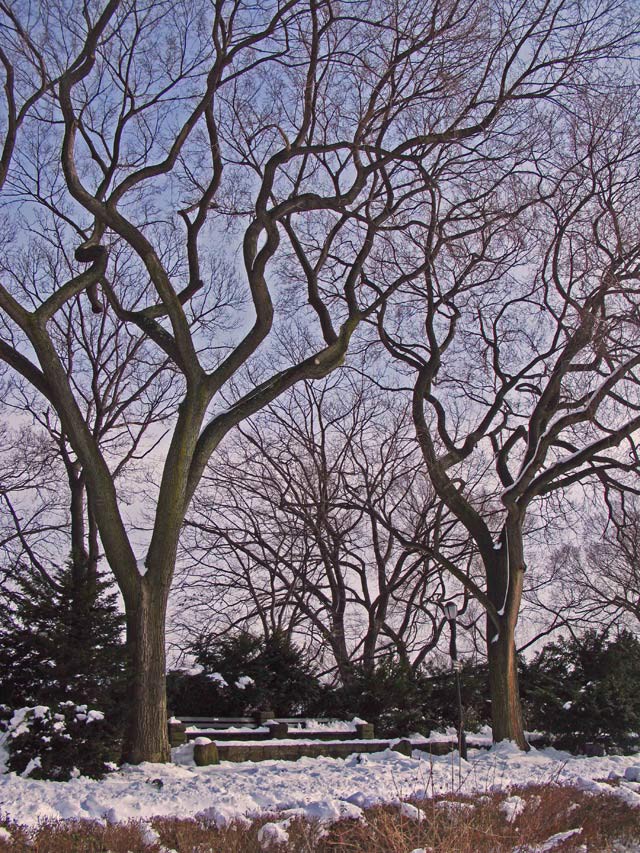
Whereas the previous week I was more inclined to step back and take in the entire vista, I now focused on smaller details, such as the individual flowers poking out from under the snow.

To examine the plants closely was to realize that-snow or not-they were preparing for spring, and many of the buds, such as the ones pictured, belonging to a sumac, seemed to have grown larger and more engorged during the intervening week. In short, I felt inspired by nature’s fundamental ambivalence to the sort of vagaries that humanity takes so seriously.

On the way out of the park, the birds were chirping under an old sycamore tree.

Change is slow, they seemed to sing, but it is always here.

Matthew Gallaway is a writer who lives in Washington Heights. His first novel, ‘The Metropolis Case,’ will be published in 2010 by Crown. You can see him read for three whole minutes tonight at Housing Works in Manhattan!
The Styles Of Lady Gaga
It is indeed difficult to assign an accurate taxonomy to the many costumes worn by Lady Gaga, but I feel like this is an admirable effort: “By their very nature, the garments defied description. But here’s an attempt to encapsulate three of them: Muppet Wonder Woman; Joan Collins Jedi Nun; Jellyfish bride humidity disaster area.”
Make A Right At Ballcup Lane And You Can't Miss It
Striking a blow for common sense and tradition, a town council in West Yorkshire, England, has reconsidered its decision to rename a railway underpass and has restored it to its original designation of Tickle Cock bridge.
Broken Social Scene, "World Sick"
The sprawling and wonderful Canadian collective Broken Social Scene have released a new song (mp3 there). It’s called “World Sick,” and it is pretty sprawling and wonderful, and it will be on their new album which comes out in May. The video above is of them playing it on stage at last fall’s North By Northeast music conference in Toronto. They look like Molly Hatchet with all those guitars up there.
Famous Person Has Press Conference on TV
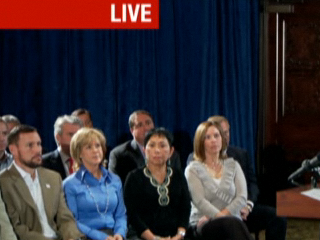
This morning, a famous person held a press conference, in which he talked about himself. He said, while speaking about himself, that he’d been selfish.
